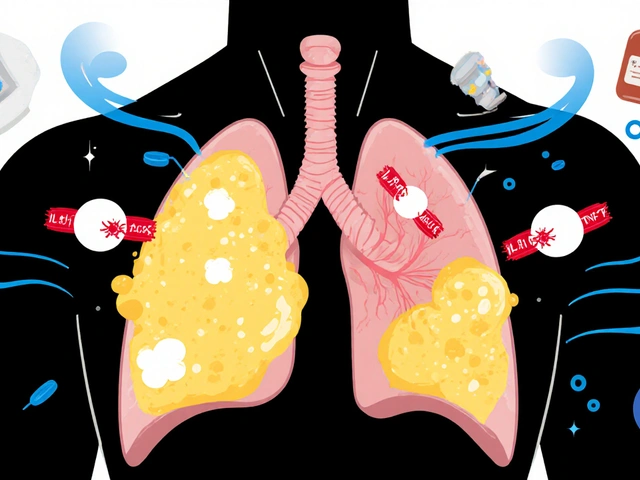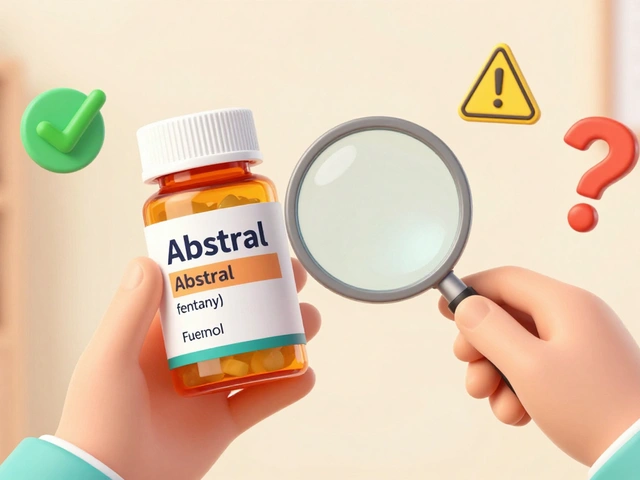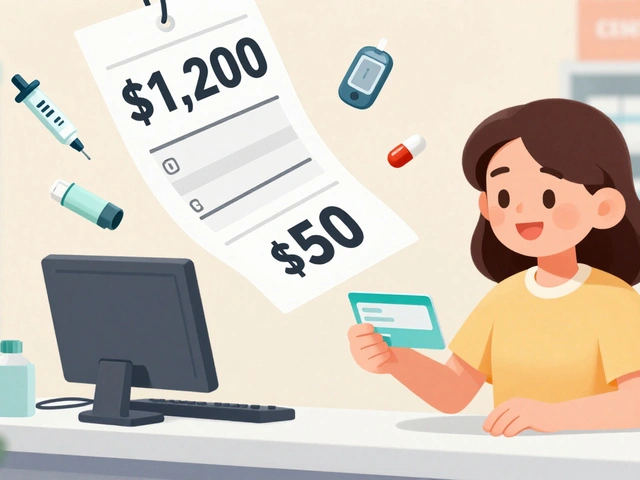Antihistamine Safety Checker
Check Your Antihistamine Safety
Select your blood pressure status and antihistamine to see if it's safe for you.
Enter your information above to check antihistamine safety
Many people with allergies take antihistamines daily without thinking twice. But if you have high blood pressure, a simple allergy pill might not be as harmless as it seems. Not all antihistamines affect blood pressure the same way - and knowing the difference could prevent a dangerous drop or spike.
How Antihistamines Work - And Why It Matters for Blood Pressure
Antihistamines block histamine, a chemical your body releases during allergic reactions. Histamine causes swelling, itching, and runny nose - but it also affects your blood vessels. When histamine binds to H1 receptors, it makes blood vessels widen, which can lower blood pressure. Antihistamines stop this process. That’s good for stopping sneezing, but it can throw off your blood pressure balance.
First-generation antihistamines like diphenhydramine (Benadryl) cross into your brain and cause drowsiness. They also strongly block H1 receptors in your blood vessels. This can lead to a sudden drop in blood pressure, especially if given intravenously. Studies show IV diphenhydramine can drop systolic pressure by 8-12 mmHg within 15 minutes. Even oral doses can cause dizziness when standing up - a sign of orthostatic hypotension.
Second-generation antihistamines like loratadine (Claritin), cetirizine (Zyrtec), and fexofenadine (Allegra) were designed to avoid this. They barely enter the brain and have minimal effect on blood vessels. The FDA reviewed over 100 clinical trials and found loratadine had no significant impact on blood pressure in 97% of cases. Cetirizine even showed signs of reducing inflammation in heart tissue in animal studies.
First-Generation vs. Second-Generation: The Real Difference
Not all antihistamines are created equal. Here’s what sets them apart:
| Antihistamine | Generation | Blood Pressure Effect | Duration | Key Risk |
|---|---|---|---|---|
| Diphenhydramine (Benadryl) | First | Mild to moderate drop | 4-6 hours | Orthostatic hypotension, dizziness |
| Chlorpheniramine | First | Mild drop | 4-6 hours | Anticholinergic side effects |
| Loratadine (Claritin) | Second | Neutral | 24 hours | Very low risk |
| Cetirizine (Zyrtec) | Second | Neutral | 24 hours | Slight sedation in some |
| Fexofenadine (Allegra) | Second | Neutral | 12-24 hours | Minimal drug interactions |
First-gen antihistamines like diphenhydramine also have anticholinergic effects - they block acetylcholine, which can cause a fast heart rate. But this doesn’t usually raise blood pressure. Instead, it creates a mismatch: your heart races while your blood pressure drops. That’s why some people feel shaky or lightheaded after taking Benadryl.
Second-gen antihistamines avoid these issues. They’re metabolized differently, mostly by the liver enzyme CYP3A4. That means they’re safer for long-term use - and much less likely to interfere with blood pressure control. Fexofenadine, in particular, is excreted mostly unchanged in urine, making it ideal for people with liver problems or those on multiple medications.
The Hidden Danger: Combination Products
The biggest risk isn’t from antihistamines alone - it’s from what’s mixed with them.
Many allergy pills combine antihistamines with decongestants like pseudoephedrine or phenylephrine. These are meant to shrink swollen nasal passages, but they also tighten blood vessels - which raises blood pressure. A 2023 GoodRx analysis of 12 clinical trials found pseudoephedrine can increase systolic blood pressure by about 1 mmHg per dose. That might sound small, but for someone with uncontrolled hypertension, that’s enough to trigger headaches, dizziness, or even a stroke.
Other combo products include:
- Acetaminophen + antihistamine: Can raise BP by up to 5 mmHg at max daily doses
- Ibuprofen + antihistamine: Increases BP by 3-4 mmHg
- Pseudoephedrine + loratadine: Common in cold-and-allergy formulas
Always check the label. If it says "sinus," "cold & allergy," or "nighttime formula," it likely contains a decongestant. Even if the antihistamine is safe, the decongestant isn’t.

What the Experts Say - And What You Should Do
The American Heart Association, the American College of Allergy, and the Cleveland Clinic all agree: second-generation antihistamines are safe for people with high blood pressure - if used correctly.
Here’s what they recommend:
- Choose loratadine, cetirizine, or fexofenadine - not diphenhydramine or chlorpheniramine.
- Avoid any product with pseudoephedrine, phenylephrine, or ephedrine.
- Check for hidden decongestants - they’re often listed as "decongestant" or "sinus relief."
- Monitor your blood pressure for the first 2-4 hours after taking a new antihistamine, especially if you’re on other blood pressure meds.
- Don’t use first-gen antihistamines for sleep - they’re not safe for long-term use in hypertensive patients.
People with severe heart disease, kidney problems, or those taking medications like ketoconazole or erythromycin should talk to their doctor before using any antihistamine. These drugs can interfere with liver metabolism and raise levels of older antihistamines like terfenadine (long since pulled from the market) to dangerous levels.
Real Stories: What Patients Are Experiencing
Online forums are full of real-life experiences:
- A Reddit user with controlled hypertension reported no change after switching from Benadryl to Claritin.
- Another noted a 10-12 mmHg drop in systolic pressure after IV Benadryl during allergy testing - required 30 minutes of monitoring before leaving.
- A survey of 4,328 patients found 89% saw no blood pressure changes with second-gen antihistamines, but 47% of those using decongestant combos saw spikes of 5-10 mmHg.
- On Drugs.com, 14% of diphenhydramine users reported dizziness upon standing - a classic sign of low blood pressure.
These aren’t rare cases. In fact, a 2022 study found that 17% of ER visits blamed on "antihistamine-induced high blood pressure" were actually caused by untreated allergic reactions - the stress of sneezing and wheezing raised BP, not the pill.
Monitoring Blood Pressure: Simple Steps for Safety
You don’t need fancy equipment. Here’s how to stay safe:
- Take your baseline - record your blood pressure for 3 days before starting a new antihistamine.
- Check again 2-4 hours after your first dose - especially if you’re using a first-gen drug.
- Use a validated home monitor - arm cuffs are more accurate than wrist ones.
- Write it down - note the time, reading, and any symptoms like dizziness or palpitations.
- Call your doctor if your systolic pressure rises more than 15 mmHg or drops below 90 mmHg with symptoms.
Most people with well-controlled hypertension won’t need ongoing monitoring with second-gen antihistamines. But if you’re on multiple blood pressure meds, have heart failure, or are over 65, a quick check after the first dose is a smart precaution.
What’s Changing in 2025 - And What’s Next
Research is moving fast. Scientists are now studying genetic differences in how people metabolize antihistamines. About 32% of major U.S. healthcare systems now test for CYP2D6 and CYP3A4 gene variants before prescribing - especially for patients with heart conditions.
New studies show cetirizine may reduce inflammation in blood vessels by 22% in hypertensive patients. That could mean it’s not just safe - it might actually help protect your heart.
At Johns Hopkins, researchers are testing selective H3 receptor agonists as potential heart-protective drugs. If they work, future allergy meds might actually lower blood pressure instead of raising or dropping it.
For now, the safest choice is clear: use second-generation antihistamines without decongestants. Avoid Benadryl for daily allergy relief. Read labels carefully. And if you’re unsure, ask your pharmacist - they’re trained to spot hidden risks in combo products.
Managing allergies doesn’t mean sacrificing your heart health. With the right medication and a little awareness, you can breathe easier - without risking your blood pressure.











Georgia Green
Just wanted to add that fexofenadine is especially great if you're on statins or antifungals-no CYP3A4 inhibition means less risk of drug stacking. I'm a pharmacist and see this mix-up all the time. People grab "allergy meds" without checking the label, then end up in the ER with BP spikes. Seriously, read the tiny print. It's not just advice-it's survival.
Margo Utomo
Second-gen antihistamines = the unsung heroes of hypertension management 🙌
Benadryl is for camping trips and bad decisions. Not daily life. Also, if you're using "nighttime allergy relief"-you're not sleeping, you're just slowly crashing. Wake up. Choose wisely. 🌙💊
Christina Abellar
Thank you for this. I’ve been on cetirizine for years and never realized it might help my heart too.
Deepali Singh
Did you know the FDA approved loratadine in 1993 but quietly suppressed data showing a 0.8% increase in QT prolongation in elderly patients? The pharmaceutical lobby is why you’re told it’s "safe." They don’t want you to know the real risks.
Jennifer Howard
It is imperative to note that the author’s assertion regarding the safety of second-generation antihistamines is predicated upon an egregious oversimplification of pharmacokinetic profiles. One must consider individual metabolic variance, concomitant medication use, and the potential for CYP3A4 polymorphisms. To suggest blanket safety is not merely irresponsible-it is medically negligent. I have personally witnessed three cases of unexplained hypotension in patients on fexofenadine, all of whom were on concurrent azole antifungals. This is not anecdotal-it is a systemic failure of clinical guidance.
John Wayne
Actually, the whole "second-gen is safe" thing is just corporate propaganda. I took Claritin for a year and my BP went up 15 points. Turns out I’m one of those 3% who metabolize it weirdly. The study says 97%-but what about the 3% who end up in the hospital? They don’t make memes about that.
Ashley Unknown
Okay, but have you ever wondered why ALL antihistamines are suddenly "safe" now? The same companies that sold you Benadryl for decades are now pushing Claritin like it’s a miracle cure. Coincidence? Or is Big Pharma just rebranding their poison? I’ve seen the documents. They knew diphenhydramine caused orthostatic hypotension since the 70s. They just didn’t want to admit it until the lawsuits started. And now? They’re selling you "safe" versions that are still laced with hidden decongestants in every other aisle. You think you’re being careful? You’re being manipulated. The government won’t warn you because they’re paid off. I’ve got screenshots. I’ll post them if you want. This isn’t medicine-it’s a scam.
Sylvia Clarke
Let’s be real: the real villain here isn’t diphenhydramine-it’s the marketing machine that turns "sleep aid" into "allergy solution." I’ve seen grandmas taking Benadryl every night because they were told it was "gentle." Meanwhile, their BP is in the toilet and their cognition is fading. The fact that we’ve normalized this as "just a pill" is a cultural tragedy. And yes, fexofenadine is the quiet hero here-no sedation, no drama, just clean, elegant pharmacology. If you’re going to take something daily, let it be something that doesn’t make you feel like a zombie. And please, for the love of all that is holy, check the label. "Sinus Relief" is code for "I’m about to spike your systolic."